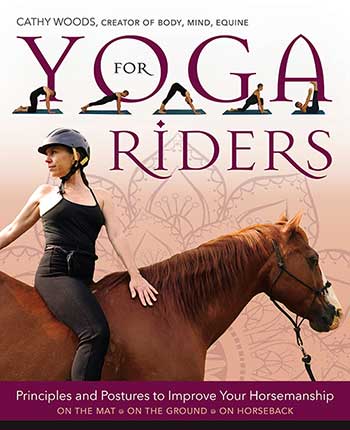
An excerpt from Yoga for Riders: Principles and Postures to Improve Your Horsemanship by Cathy Woods.
When going for a walk or jog, some of us innately feel what gait, swing, and motion is optimal. If we’re paying attention, we know what feels smooth and uses the least amount of energy yet works our muscles in a safe, effective way.
However, others of us have not learned proper alignment, or we have developed bad habits around our posture and movement. The physical aspect of yoga is a practice that helps us improve in these areas so we move better, become less sore, and avoid injury.
Yoga also means spending integrated (and preferably uninterrupted) time with yourself, for the purpose of refining your body and mind. The yoga mat and meditation cushion are ideal places to come to know yourself better—a place for personal "groundwork" and "collection," so to speak.
After I’ve spent time on the mat doing yoga postures, I am more keenly aware of my body. My muscles feel engaged, and I’m more cognizant of how to properly use them. The residual effects linger throughout the day.
This translates into a more efficient use of my body during all my other activities—for example, when lifting a hay bale, I engage my legs more to keep strain off my back, and I am careful to grasp and lift the bale evenly, so I don’t risk straining a shoulder.

If you’ve ever observed runners on a treadmill at the gym or out for a jog in the park, you will have noticed different styles. Some flop their arms around or plant their feet heavily, while others appear naturally gathered, smooth, and efficient.
Of course, we see this with equestrians, too. Some engage their legs, use their hands properly, and are aware of their posture and overall body mechanics while on horseback. You may have heard one rider call another a “natural.” Others are a bit sloppy looking—or as horse people might joke, sit on the horse “like a sack of potatoes.”
It is true that some individuals seem to be born gifted with great body awareness, balance, and refined movements, along with good instincts, while most of us have to be taught to achieve good form. That is what is wonderful about yoga training! It assists you in performing any physical activity with awareness and ease, no matter what you are doing.
A person performing Dancer Pose (a yoga balance posture) and a person asking a horse to side-pass, are not so different They both require using many tiny muscles, and mental focus also comes into play—when the mind is imbalanced, so will be the body.
When we don’t know how to manage or control our muscles, or if they are weak, or if we aren’t harnessing our attention, we’ll stumble out of the posture or struggle to provide clear aids that our horse can understand.


Training the body can seem easy compared with training the unfocused “monkey mind” (as the Buddhists call it, referring to the unsettled, restless, and indecisive mental state common to humans). You can learn skills to collect the mind through meditation techniques (which is also an aspect of “true yoga”—I’ll explain more about “true yoga”).
It is hard to do anything when your thoughts are all over the place or when you are distracted. One effective method is directing attention to your breath; it is simple, yet powerful—so in addition to using yoga postures to improve your horsemanship, you can also use breathing and meditative techniques.
Training the mental muscle is like developing your other muscles. Without focus, it can be hard to complete a task, whether at your desk or working with horses—not to mention the excess energy it takes to be scattered.
In deep meditation, you are fully united and focused, without your attention wavering. Through practice, you will learn to carry that focus with you to your work with horses. And this can yield amazing results.
This excerpt from Yoga for Riders by Cathy Woods is reprinted with permission from Trafalgar Square Books (www.horseandriderbooks.com).
You can find more interesting reading in our section on Books and more valuable information in our section on Health & Education.

































